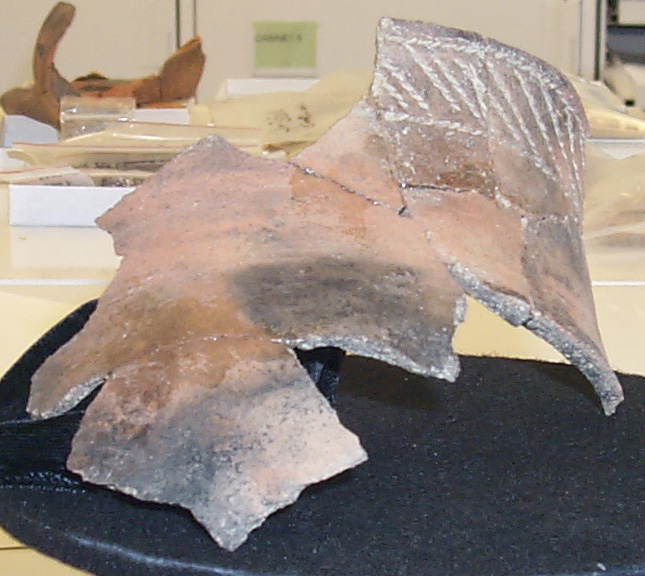 |
| Potomac Salad |
When the English arrived at Virginia in 1607, they found a vast wilderness inhabited by Native Americans who had lived in the land of Tsenacomoco (the Native American name for the tidewater region of Virginia; a.k.a. the coastal plain that is east of the fall line) for centuries. The English arrived thinking that they could thrive in the "new world" by replicating English towns and English farms growing English foods. After the Starving Time of 1609 - 1610 where most of them died of starvation and disease, they realized just how wrong they were. Under the leadership of John Smith, the English began to learn that the key to survival in the "new world" was to adopt the ways of the native people that were thriving. That meant that the English would have to learn the ways of the "salvages."
 |
| A Patawomeck Pot traded to an English Colonist. Analysis shows that a maize and venison stew was the last food cooked in it before it was discarded by the colonist after his "Indian" meal. |
 |
| The 2009 United States Native American $1 Coin Depicting a Native American Woman Tending to a Milpa. |
This Thanksgiving, take a look at your table. There is still much Patawomeck and Powhatan Indian influence at work even today. The turkey, corn (maize), beans, squash and pumpkin and North American varieties of nuts were all foods that the Natives of Tsenacomoco taught the English to hunt, grow, cook, and enjoy. There is no question that the three sisters saved Jamestown from disaster. And, the importance of those three foods are seen today more than ever.
To celebrate Thanksgiving this year, I decided to create a dish that, I think, captures the food preferences of both the English and the Natives of the 17th century. I call it "Potomac Salad." It is a dish with Patawomeck Native American ingredients seasoned with ingredients like the English would have used.
Potomac Salad
1 medium sized butternut squash
1 15.5 ounce can of kidney beans, rinsed
1 15.5 ounce can corn, drained
Bacon Fat, warmed until liquefied
Apple Cider Vinegar (ACV)
1 Tsp Dijon Mustard
1/2 medium sized red onion cut into thin strips
Salt & Pepper to taste
Pinch of ground cayenne pepper (optional; but I have strong reason to believe the English colonists in 17th century Virginia would have used it often instead of black pepper)
Peel and cut the squash into about 1" cubes. Reserve the seeds. Toss the squash with salt and pepper and a little bacon fat (Virginia smoked pork). Toss the seeds with a little bacon fat too. Roast the squash and seeds in a 350 F degree oven turning them once or twice until done. The seeds should be done in about 15 - 20 minutes. The squash should be done in about 30 minutes.
Make a vinaigrette using 4 TBS of bacon fat, 4 TBS of ACV, the mustard, salt, pepper, and cayenne. Add the corn, beans, roasted squash, onion, and vinaigrette to a skillet and heat over medium heat until hot. Use the seeds as garnish and serve as a side or by itself over mixed greens.

No comments:
Post a Comment